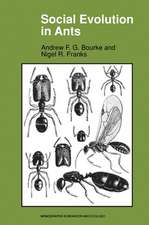Self–Organization in Biological Systems
Autor Scott Camazine, Jean–louis Deneubourg, Nigel R. Franks, James Sneyd, Guy Theraulaen Limba Engleză Paperback – sep 2003
Preț: 565.58 lei
Preț vechi: 698.25 lei
-19% Nou
Puncte Express: 848
Preț estimativ în valută:
108.23€ • 113.23$ • 89.90£
108.23€ • 113.23$ • 89.90£
Carte tipărită la comandă
Livrare economică 02-16 aprilie
Preluare comenzi: 021 569.72.76
Specificații
ISBN-13: 9780691116242
ISBN-10: 0691116245
Pagini: 562
Ilustrații: 8 colour pl 180 illustrations, 3 tables, 32halftones
Dimensiuni: 157 x 233 x 34 mm
Greutate: 0.8 kg
Editura: Princeton University Press
Locul publicării:Princeton, United States
ISBN-10: 0691116245
Pagini: 562
Ilustrații: 8 colour pl 180 illustrations, 3 tables, 32halftones
Dimensiuni: 157 x 233 x 34 mm
Greutate: 0.8 kg
Editura: Princeton University Press
Locul publicării:Princeton, United States
Public țintă
Adult: General. Academic/professional/technical: Undergraduate. Academic/professional/technical: Postgraduate. Academic/professional/technical: Research and professionalNotă biografică
Scott Camazine is the author of The Naturalist's Year and Velvet Mites and Silken Webs. Jean-Louis Deneubourg is Research Fellow at the Belgian Fund for Scientific Research and at the Centre for Non-Linear Phenomena and Complex Systems at the Université Libre de Bruxelles, Belgium, where he is also Professor of Behavioral Ecology. Nigel R. Franks is Professor of Animal Behavior and Ecology at the University of Bristol and the coauthor of The Social Evolution of Ants (Princeton). James Sneyd is Associate Professor of Mathematics at Massey University, New Zealand and the coauthor of Mathematical Physiology. Guy Theraulaz is Research Fellow at the National Center for Scientific Research in Toulouse, France, and at Paul Sabatier University. Eric Bonabeau is Chief Scientist at EuroBios in Paris, France. Bonabeau and Theraulaz are coauthors of Swarm Intelligence: From Natural to Artificial Systems.



























